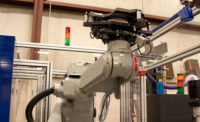Uncovering the best ways to cut water and energy use in meat and poultry plants is akin to solving a puzzle. While obvious measures alone can lead to big paybacks, it takes patience and creativity for operators to uncover all possible sources of waste and the best strategies for optimal gains.
The benefits from initiatives can be substantial — lower utility bills, greater operating efficiencies, a positive impact on the environment and a more favorable reputation in the marketplace, community and with employees.
Yet, incorporating the necessary operational changes is not always easy. Operators need the money to invest in new technologies, have the resilience to eschew short-term gains for larger long-term savings and be able to entice change-resistant workers to adopt more effective conservation practices, analysts say.
Mike Bartikoski, senior vice president of operations for Land O’Frost Inc., lists the four major challenges to implementing effective conservation measures as identifying the issues, quantifying the opportunities, sourcing the right economic and sustainable solutions, and funding and completing the projects.
“There is also the inevitable resistance to change, so creating awareness of the issues and opportunities within operations and to management is key,” he says. “As food consumers’ interests in sustainability and issues like carbon footprints continue to evolve, we will find ourselves faced with increased demands to measure and improve these areas.”
Land O’Frost, a Munster, Ind.-based supplier of pre-sliced, pre-packaged lunch meats and specialty hot dogs and sausages, has reduced its electrical expenses over the past few years through such actions as using energy efficient light-emitting diode (LED) lighting instead of fluorescent or halogen lights and leveraging motion-activated lighting, Bartikoski says.
In addition, the producer is using more efficient motors, and re-engineering processes to reduce loads from heating, ventilation and air conditioning (HVAC) activity, as well as from refrigeration and other big energy eaters, he says.
Getting worker buy-in on conservation strategies, meanwhile, is crucial as projects often require adjustments to operating procedures. He says many plant employees have the experience to provide key insights on improving practices and reducing expenses.
The first steps in developing a conservation strategy are to monitor, discuss and set monthly goals around water usage, wastewater flows and electrical consumption, Bartikoski says, adding “we get results against what we measure.”
Keep an eye on consumption
Closely tracking water and energy expenditures is a basic, but essential step in cutting use in meat and poultry plants, says Matt Howard, vice president of Water Council, in Milwaukee, Wis., the North American headquarters for the Alliance for Water Stewardship, a global collaboration of organizations that focus on sustainable water resource management.
“Meat and poultry processors should be aware of how much water they are using, the cost and the connection between energy and water use in a facility,” he says. “There should be tight operations without obvious wasting of water.”
Savings from water reduction can potentially be immense because many plants have two or three facility wash-downs in a 24-hour period and are using millions of gallons of water for each of the cycles, Howard says.
Operators can conserve water during such cleanings by incorporating non-water-based solvents and curtailing energy use in HVAC systems as cooling towers, he says.
“Internal energy efficiency processes can have unintended consequence in also lowering water usage,” he says.
There also is a host of residual gains from using less water, including fewer discharge and treatment costs, and, for companies operating in regions with drought and water scarcity issues, the ability to function effectively during periods of government-ordered mandatory conservation.
Howard adds that operators can identify water saving opportunities by having outside consultants conduct plant audits, or by arranging for possible low- or no-cost audits from municipalities.
Even with such potential windfalls, some plant managers still may lack the impetus to focus on conservation methods. Because current water prices are relatively low, operators may find it difficult to justify technology expenditures or the time necessary to develop and implement strategies for what they perceive as relatively minor returns on investments, he says.
Nevertheless, there are lower-cost steps that processing plants can take to save water, including turning off hoses, machinery and lights when not in use, says Tracy Walker, operations manager for West Liberty Foods, a West Liberty, Iowa-based producer of turkey, ham chicken and beef products.
“We have seen huge changes and a lot of savings from very, very small things,” she says, “and the majority of the savings doesn’t involve spending money. It is from a culture shift, an awareness and the involvement of plant associates.”
Water savings is part of a major conservation push that began about eight years ago when West Liberty Foods established employee teams to focus on reducing the use of water, electricity, carbon dioxide and steam and to recycle cardboard and plastic at its facilities, including the Tremonton, Utah, plant, she says.
In one instance, the company was able to lower water consumption from 8,736 gallons to 364 gallons a day by reducing belt bath water usage on an oven at the Tremonton facility, says Sara Andersen, environmental supervisor.
West Liberty Foods also cut annual total water use by 19.7 percent at the facility through such means as replacing leaky hoses and fixed nozzles and training water team members on how to reduce washout times, she says.
An emphasis on the environment
Walker says protecting the environment is the main driver behind such efforts.
“It has never been about money,” she says. “We have some huge savings but also some huge expenses to get where we are. It is about doing the right thing, minimizing the negative footprint and then sharing information between plants in order to also be successful in the different locations.”
The company operates six facilities in Iowa, Illinois, Utah and Arkansas.
Expenses include adding energy-efficient light fixtures and attaching variable frequency drives (VFDs) to machines to better control the speed of production lines and eliminate the need to constantly turn equipment on and off, which can cause power surges that increase energy costs, she says.
Internal and external auditors review the operations every six months, Walker adds.
West Liberty Foods educates the more than 700 workers in the Tremonton facility on energy saving procedures upon hiring and retrains all associates annually, Andersen says.
Though it often requires a different mindset for workers to begin focusing on conservation, Walker says the potential for strong savings should entice meat and poultry plant operators to implement new procedures, and having support from upper management for the initiatives is crucial.
Such management buy-in at West Liberty Foods “took away the fear of failure because we knew we were going to keep trying the conservation programs until they were successful,” she says. “Giving up was never an option.”
Other West Liberty Foods programs include the incorporation of clean-in-place (CIP) systems in ovens and replacing plastic belts that have nooks and crannies that can harbor pathogens with solid belting that is quicker to clean, Walker says.
The company also is considering the possible use of solar energy, which may require the installation of solar panels on top of a covered parking lot at the Tremonton facility, Andersen says, noting the plant rooftop cannot support such panels because of the presence of ammonia piping.
“The piping is a challenge for the meat industry and other cold storage facilities that want to access solar energy so its use will require creativity,” she says. West Liberty Foods is gathering quotes for the project “to see if there is a return on investment,” she says.
Funding is fundamental
Cost is a critical component in implementing conservation measures and that may require operators to be flexible in considering funding alternatives.
Options include seeking grants, loans, discounts and other incentives that may be available from utility companies and municipalities, Bartikoski says.
“An in-depth assessment of what process improvements can be made and how those projects can impact quality and reduce costs may reveal that the return will be greater than expected,” he says.
Bartikoski adds that meat and poultry plants also can reduce energy use by adjusting lighting levels, light sources and the time lights are on in low-traffic areas, and that decreases in water use also will result in lower associated water treatment costs.
Additional Land O’Frost efforts, meanwhile, include cutting energy consumption in its cooking activities by leveraging efficient and high-yield thermal processes, he says.
A future focus will be on reducing energy and water consumption by upgrading compressed air and refrigeration controls, Bartikoski says, which includes having air systems that are leak free while properly maintaining the technologies.
“Compressed air is often overlooked and could be thought of as ‘hidden utility,’” he says.
Land O’Frost also will look at adding variable speed drives to plant equipment for greater efficiencies, while conducting a comprehensive review of wastewater systems to pinpoint water usage, ways to better manage the handling of cleaning and treatment agents and the separation of solids in processes, Bartikoski says.
“The key is to take a long view of these projects as the payback may not always be as quick as other business-driven savings projects,” he says. NP










